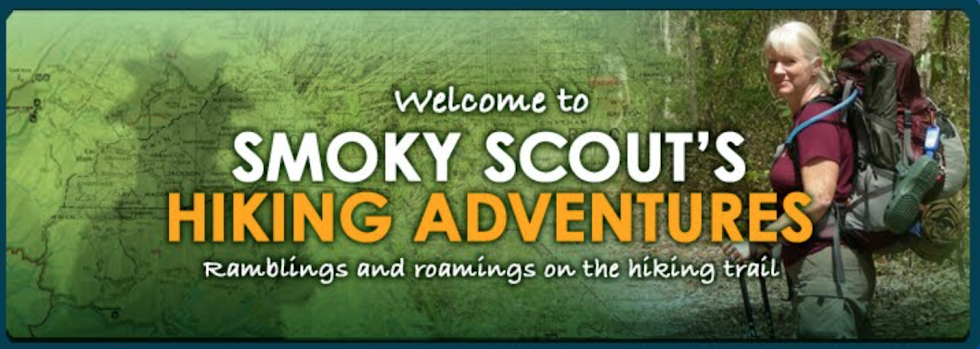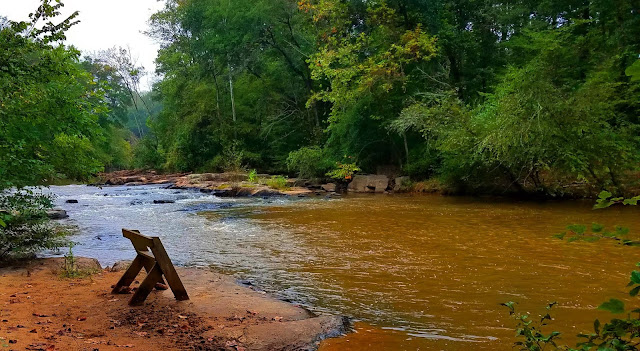Carolina Thread Trail: South Fork Trail – 9/24/18 – 4 Miles
Has this ever happened to you: itching for a walk in some
new woods but unwilling to drive 4+ hours roundtrip from Charlotte, NC to the
mountains on a Monday? Me too. Solution: the Carolina Thread Trail.
I’ve marked trails of interest on the CTT website but have
been holding out until colder weather when mountain trails are inaccessible or
dangerous to hike alone. But that itch wouldn’t let me wait and I pored over
the list to see what would suit my time frame. South Fork Trail caught my
interest, a short drive away, a two-mile one-way walk along the South Fork
River connecting McAdenville and Lowell. [Note: not to be confused with
South Fork Rail Trail in Lincolnton, NC.]
Parking and trailhead access are right off Exit 23 of I-85
in North Carolina, adjacent to the R.Y. McAden River Access. There are great signs telling the history of
the area and practical info like the street address. The entire trail has distance
markers at .5, 1.0 and 1.5 miles and section designations for 911 location. At
2 miles, the trail ends at a residential neighborhood cul-de-sac, so no public parking,
but there is an access path for the locals.
Only me at the trailhead on a Monday morning, so safety
first. I had left my hike plan with Jim, but I also texted him photos of the
signage along with my start time and estimated end time.
Bring your mountain bike and leave your road bike at home
for this natural surface trail. It is wide as greenways typically are, with
plenty of room for cyclists and walkers/runners to pass each other. The trail
runs alongside the South Fork of the Catawba River on land owned by Pharr Yarns Preserve, a 94.8-acre
preserve protected by Catawba Lands Conservancy (a partner with CTT).
I was on the lookout for snakes (none). On most hikes I just
tolerate spiderwebs because I use trekking poles, but for the flat walk today I
was empty handed. After running into a H-U-G-E web (do they seem bigger near a
river?) I carried a branch in front of me to ward off the big creepy-crawlies,
until I got tired of the vigilance and surrendered to the silky spiderweb
facials.
The trail immediately passes underneath I-85, giant pylons
painted with Carolina Thread Trail (CTT) and Catawba Lands Conservancy (CLC)
logos. The water was high and muddy from recent rains and the far-reaching
remnants of Hurricane Florence.
My walk began with noise from the highway and planes at
nearby Charlotte-Douglas airport, but quickly all that faded away to sounds of
crickets, cicadas, birds and flowing water. What I expected to be a pleasant
but simple walk turned into an extraordinary experience, just by looking
closely at what was right in front of me.
I took over 100 photos today!
Water was nearly always in sight through a screen of trees.
Whenever I saw a side trail, I followed it to the river’s edge. At one short
access I saw what appeared to be a very old “trail tree” with a 90-degree elbow.
At about one mile is Cable Point, a viewpoint of the river
dedicated to a former Catawba Lands Conservancy Executive Director, Dave Cable,
honoring his years of service. Foundation remains of buildings and stone
pillars of a bridge that once crossed the river are reminders of Gaston County
history.
From the website: “This
is a historic trail that was originally used by the Native Americans and then
utilized by settlers for textile mills. There were two mills in the woods along
the trail. One was the Ferguson Mill and the other one was nicknamed Pinhook.
Opened in August 1852, the Pinhook Mill was the second mill to operate along
the South Fork River. According to Gaston County historian Robert Ragan, the
mill received its name because mill workers would use bent textile pins to fish
for lunch outside the building’s windows. During the Civil War, a small
detachment of Union soldiers was sent to burn down Pinhook Mill, which was
producing cloth for the Confederacy. Upon hearing the soldiers coming, mill
superintendent William Sahms ran out to meet the Union troop, only to find them
led by his Pennsylvanian childhood neighbor. Sahms convinced the soldiers to
spare the mill and the soldiers burnt the bridge instead. The stone pillars of
the bridge are still in the river.”
The river was split in several places by small islands and
rock outcroppings. In low water (not today) easy wading could access these nice
little spots to feel like you are “in the river.” From the side paths that I
saw, I’m sure I’m not the first person to think of this but…disclaimer: please use
caution when wading in any water!
Shortly after the 1.5-mile mark is a very small beach where
someone has placed a simple wooden bench to sit and contemplate the water and
time and life’s questions - or to eat lunch - or both. This is a natural
turnaround point.
My first thought: a chiminea?
I walked the remaining half-mile to the neighborhood access
point, a little surprised I didn’t encounter any residents out enjoying this
trail at the end of their street, or at least dog walking.
On the return hike, I was no longer concentrating on the
water and turned my attention to plant life. I noticed several huge silvery
leaves scattered on the ground, looked up to see where they came from: a lovely
stand of Fraser magnolias. On the tall mature trees and even on the short
saplings, they were largest Fraser magnolia leaves I’ve ever seen.
Very late fading summer flowers, some in-your-face and others
easy to miss:
White wood aster
Horse nettle
Hearts a-burstin’
Wingstem
Does anybody know this one?
Orange jewelweed aka spotted touch-me-not
Goldenrod
Mushrooms, grapevines and walnuts, oh my!
Who would have thought there was so much beauty on a little
strip of riverbank accessed underneath power lines and a highway overpass? Who do you know who would enjoy this little walk
in the woods? South Fork Trail is a four-season trail, easily accessible in any
weather or temperature, and something new can be discovered every day of the
year.
“Everything has beauty, but not everyone sees it.” ~Confucius











































No comments:
Post a Comment